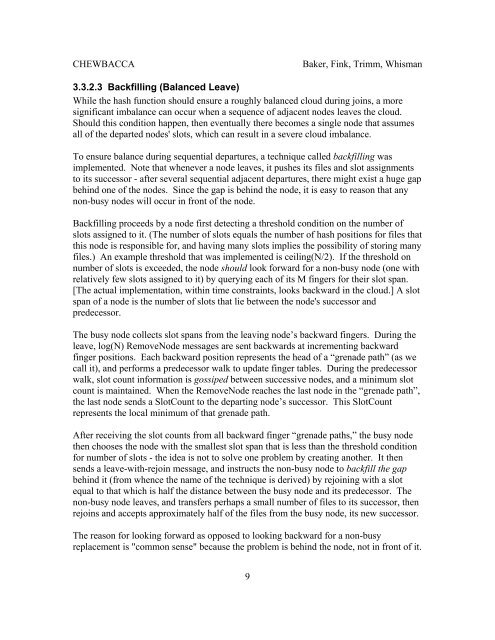Implementing a Distributed Peer to Peer File Sharing System ... - Umbc
Implementing a Distributed Peer to Peer File Sharing System ... - Umbc
Implementing a Distributed Peer to Peer File Sharing System ... - Umbc
You also want an ePaper? Increase the reach of your titles
YUMPU automatically turns print PDFs into web optimized ePapers that Google loves.
CHEWBACCA Baker, Fink, Trimm, Whisman<br />
3.3.2.3 Backfilling (Balanced Leave)<br />
While the hash function should ensure a roughly balanced cloud during joins, a more<br />
significant imbalance can occur when a sequence of adjacent nodes leaves the cloud.<br />
Should this condition happen, then eventually there becomes a single node that assumes<br />
all of the departed nodes' slots, which can result in a severe cloud imbalance.<br />
To ensure balance during sequential departures, a technique called backfilling was<br />
implemented. Note that whenever a node leaves, it pushes its files and slot assignments<br />
<strong>to</strong> its successor - after several sequential adjacent departures, there might exist a huge gap<br />
behind one of the nodes. Since the gap is behind the node, it is easy <strong>to</strong> reason that any<br />
non-busy nodes will occur in front of the node.<br />
Backfilling proceeds by a node first detecting a threshold condition on the number of<br />
slots assigned <strong>to</strong> it. (The number of slots equals the number of hash positions for files that<br />
this node is responsible for, and having many slots implies the possibility of s<strong>to</strong>ring many<br />
files.) An example threshold that was implemented is ceiling(N/2). If the threshold on<br />
number of slots is exceeded, the node should look forward for a non-busy node (one with<br />
relatively few slots assigned <strong>to</strong> it) by querying each of its M fingers for their slot span.<br />
[The actual implementation, within time constraints, looks backward in the cloud.] A slot<br />
span of a node is the number of slots that lie between the node's successor and<br />
predecessor.<br />
The busy node collects slot spans from the leaving node’s backward fingers. During the<br />
leave, log(N) RemoveNode messages are sent backwards at incrementing backward<br />
finger positions. Each backward position represents the head of a “grenade path” (as we<br />
call it), and performs a predecessor walk <strong>to</strong> update finger tables. During the predecessor<br />
walk, slot count information is gossiped between successive nodes, and a minimum slot<br />
count is maintained. When the RemoveNode reaches the last node in the “grenade path”,<br />
the last node sends a SlotCount <strong>to</strong> the departing node’s successor. This SlotCount<br />
represents the local minimum of that grenade path.<br />
After receiving the slot counts from all backward finger “grenade paths,” the busy node<br />
then chooses the node with the smallest slot span that is less than the threshold condition<br />
for number of slots - the idea is not <strong>to</strong> solve one problem by creating another. It then<br />
sends a leave-with-rejoin message, and instructs the non-busy node <strong>to</strong> backfill the gap<br />
behind it (from whence the name of the technique is derived) by rejoining with a slot<br />
equal <strong>to</strong> that which is half the distance between the busy node and its predecessor. The<br />
non-busy node leaves, and transfers perhaps a small number of files <strong>to</strong> its successor, then<br />
rejoins and accepts approximately half of the files from the busy node, its new successor.<br />
The reason for looking forward as opposed <strong>to</strong> looking backward for a non-busy<br />
replacement is "common sense" because the problem is behind the node, not in front of it.<br />
9











